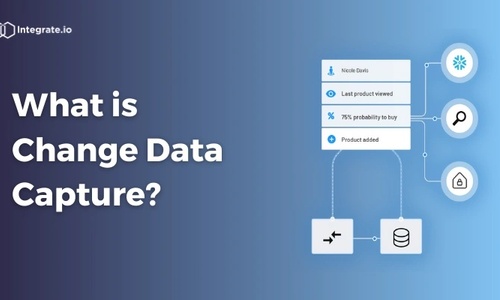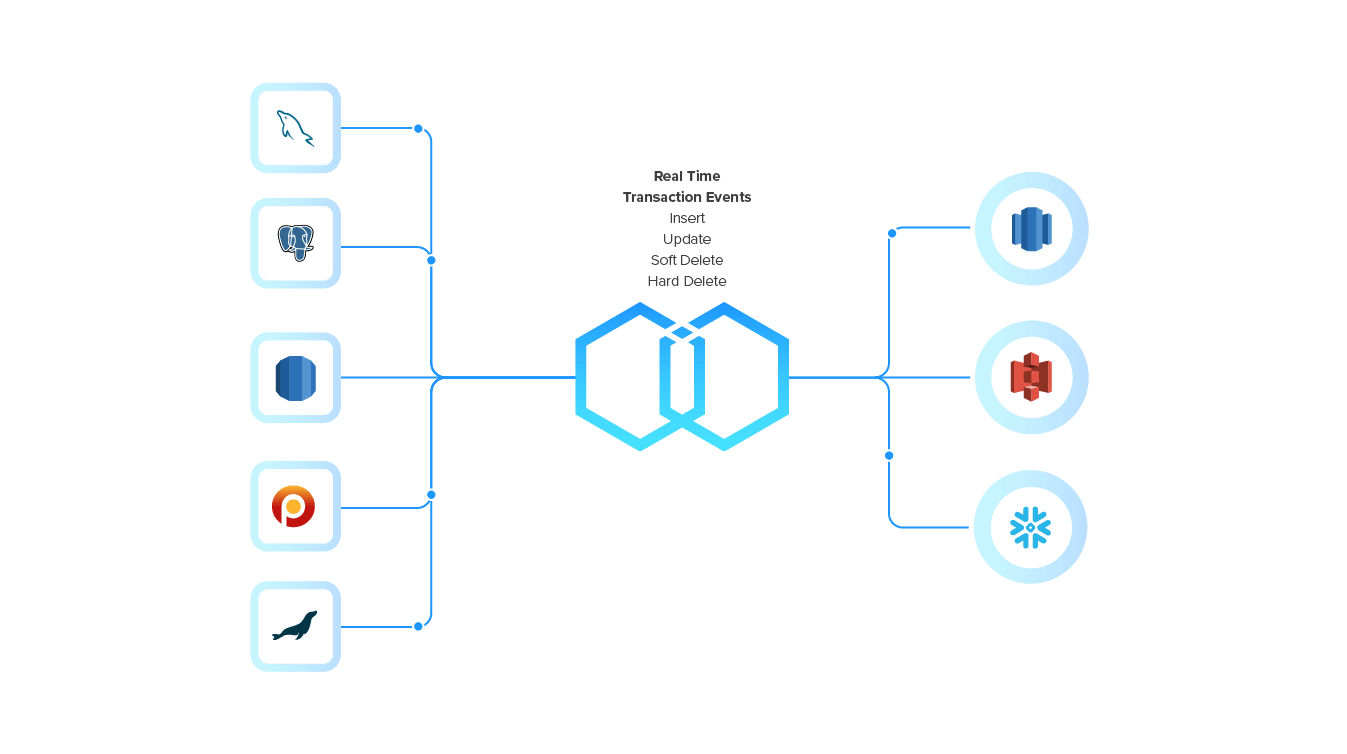As businesses strive to make data-driven decisions, the need for efficient and timely data integration practices becomes increasingly evident. Enter Change Data Capture (CDC), a technique that has revolutionized the way organizations handle data synchronization and integration. In this comprehensive guide, we'll explore the complexities of CDC, its significance in data replication, various change data capture methods of implementation, its role in ETL and ELT processes, and how platforms like Integrate.io are pioneering its application.
[Key Takeaways] Here are the key things you need to know about Change Data Capture:
CDC is a technique that detects and captures changes in source tables and data sources in real-time.
It offers a more efficient alternative to traditional batch processing methods and polling.
There are two primary CDC methods: Log-Based and Trigger-Based.
CDC is pivotal in modern ETL processes, enabling real-time data integration.
SQL Server, MySQL, and PostgreSQL are among the relational databases that can use change data capture effectively.
Platforms like Integrate.io offer robust solutions for implementing CDC in data pipelines.
What is Change Data Capture?
Change Data Capture, commonly referred to as CDC, has emerged as a cornerstone in data engineering and analytics. At its core, CDC is a technique that identifies and captures modifications made to the source database, ensuring that systems are consistently synchronized with the most up-to-date information. Historically, businesses leaned on batch data processing for new data updates, which posed limitations in a rapidly evolving business environment. With the advent of CDC, real-time data integration became achievable, offering businesses the advantage of instantaneous analytics and real-time analytics. Data sources are diverse and voluminous; CDC stands out as a scalable, efficient, and essential tool for ensuring data accuracy, optimizing resource utilization, and facilitating real-time decision-making.
Why Use CDC for Data Replication?
Change Data Capture (CDC) has emerged as a pivotal thread, weaving together real-time data integration with efficient system synchronization. But why has CDC become the go-to strategy for data replication? Let's dive into the compelling reasons that underscore the importance of CDC.
The Imperative for Real-time Data
Real-time data isn't just a luxury—it's a necessity. Whether it's a financial institution needing up-to-the-second transaction data or an e-commerce platform updating inventory in real-time, the demand for instantaneous data is omnipresent. CDC answers this call by ensuring that as soon as a change occurs in the source data, it's immediately reflected in the target system. This real-time synchronization empowers businesses to make informed decisions promptly, capitalizing on opportunities and mitigating challenges.
Efficiency and Bandwidth Conservation
Traditional data replication methods often involve the transfer of entire datasets at scheduled intervals. This approach, while thorough, is akin to refilling a water tank even when it's only half empty. CDC, on the other hand, focuses solely on the "new" or "changed" data, ensuring that only the necessary data is transferred. This conserves bandwidth and significantly reduces the source and target system load, leading to optimized performance and cost savings.
Enhanced Data Accuracy and Integrity
Data integrity is the bedrock of reliable analytics. With batch processing, there's always a time lag between when data changes in the source system and when it's updated in the target system. This lag can lead to discrepancies, especially in dynamic environments. CDC eliminates this lag, ensuring that data in the target system accurately reflects the source. This real-time accuracy bolsters confidence in analytics and insights derived from the data.
Scalability for Growing Enterprises
As businesses expand, so does their data. Traditional replication methods can struggle to keep pace with burgeoning data volumes, leading to longer update intervals and potential data mismatches. CDC, with its focus on change-only updates, offers a scalable solution. Whether a business handles gigabytes or petabytes of data, CDC ensures timely and accurate data replication without being bogged down by volume.
Seamless Integration in Hybrid Environments
Modern enterprises often operate in hybrid data environments, leveraging on-premises databases and cloud platforms. CDC shines in such scenarios, offering seamless integration across diverse data environments. Whether replicating data from an on-premises SQL database to a cloud-based analytics platform or synchronizing data between different cloud providers, CDC ensures data flows smoothly and consistently across systems.
Change Data Capture has redefined the paradigms of data replication, transitioning businesses from periodic batch updates to real-time data synchronization. CDC offers a robust, efficient, and scalable solution. By focusing on the changes, conserving resources, and ensuring data integrity, CDC empowers businesses to harness the full potential of their data, paving the way for informed decisions, optimized operations, and strategic growth.
Types of Change Data Capture: Log-Based CDC vs. Trigger-Based CDC
Change Data Capture (CDC) has firmly established itself as a linchpin in data integration, offering businesses a streamlined approach to capturing and synchronizing database changes. But like many technological solutions, CDC isn't a one-size-fits-all. Instead, it combines different methodologies, each with unique advantages and considerations. Two of the most prominent types of CDC are Log-Based CDC and Trigger-Based CDC. Let's dig into these methodologies, addressing their difficulty and determining which might be the best fit for specific scenarios.
Log-Based Change Data Capture
Understanding the Mechanism: A transaction log is at the heart of every database. Think of this log as a meticulous scribe noting every change in the database. Whether it's a new entry being added, an existing record being updated, or data being deleted, the transaction log records it all. Log-Based CDC leverages these logs, scanning them to identify and capture data changes.
Advantages:
- Minimal Performance Impact: Since Log-Based CDC directly interacts with the transaction logs and not the actual database, the operational performance of the database remains largely unaffected.
- Comprehensive Data Capture: Every change, regardless of its magnitude, is captured. This ensures a high degree of data accuracy and completeness.
- Efficiency: By bypassing the need to query the database directly, Log-Based CDC offers a swift and efficient means of capturing changes.
Considerations:
- Database Specificity: Since transaction logs can vary across different database systems, Log-Based CDC solutions often need to be tailored to specific databases.
- Log Management: For Log-Based CDC to function optimally, effective log management practices must be implemented. This includes ensuring that logs aren't prematurely truncated or archived.
Trigger-Based Change Data Capture
Understanding the Mechanism: Trigger-Based CDC, as the name suggests, relies on triggers. These are pre-defined or sets of actions automatically executed in response to specific events within the database. For instance, a trigger could be set to activate whenever data is added to a particular table. When this event transpires, the trigger captures and stores the change in a designated table.
Advantages:
- Real-time Data Capture: Triggers are instantaneous, ensuring that changes are captured in real-time.
- Flexibility: Triggers can be customized to capture specific types of changes, offering businesses a high degree of flexibility in determining what data is captured.
Considerations:
- Performance Impact: Since triggers operate directly on the database, they can impact its performance, especially if the volume of changes is high.
- Complexity: Managing and maintaining many triggers requires meticulous planning and organization.
Which CDC Method to Choose?
The decision between Log-Based and Trigger-Based CDC hinges on several factors, including the specific database system in use, the volume of data changes, performance considerations, and the desired level of customization. Businesses need to weigh the advantages and considerations of each method against their unique requirements to arrive at an informed decision.
Change Data Capture, Data Streaming, and ETL
In data management, Change Data Capture (CDC), Data Streaming, and Extract, Transform, Load (ETL) processes often intersect, each playing a pivotal role in ensuring that data is accurately captured, processed, and delivered to target systems like a data warehouse or data lake. But how do these components fit together, and what role does each play in broader data integration? Let's journey to demystify these concepts and shed light on their interplay.
Change Data Capture (CDC): As we've explored earlier, CDC is all about capturing changes in source data in real-time. Whether it's a new entry in a database, an update to an existing record, or the deletion of data, CDC ensures that these changes are immediately reflected in the target system. By focusing on changes rather than entire datasets, CDC offers a more efficient and timely approach to data replication.
Data Streaming: While CDC captures changes, Data Streaming is about transmitting this data to target systems in real-time. Think of it as a conveyor belt transporting freshly captured data to its destination without delay. Data Streaming solutions have emerged as frontrunners in this domain, offering robust and scalable platforms for near real-time data transmission.
Extract, Transform, Load (ETL): ETL is a three-step process that involves extracting data from source systems, transforming it into a desired format, and loading it into a target system. While traditional ETL processes operated in batch modes, with data being processed at scheduled intervals, the advent of CDC and Data Streaming has paved the way for real-time ETL, where data is continuously extracted, transformed, and loaded as changes occur.
The Synergy of CDC, Data Streaming, and ETL: In modern data, the synergy of CDC, Data Streaming, and ETL is evident. CDC ensures that changes are captured in real-time, and Data Streaming ensures that these changes are transmitted without delay. ETL processes ensure that the data is processed and integrated into target systems seamlessly. Together, these components offer businesses a robust framework for real-time data integration, enabling them to harness the full potential of their data.
How Integrate.io Can Help with Change Data Capture
In Change Data Capture (CDC), platforms like Integrate.io have emerged as game-changers, offering businesses robust and scalable solutions for real-time data integration. But how do these platforms facilitate CDC, and what advantages do they bring? Integrate.io offers a suite of tools designed to simplify data integration. With its intuitive drag-and-drop interface, businesses can easily create and deploy data pipelines, integrating data from diverse sources into a unified platform. Integrate.io's CDC capabilities ensure that changes in source data are captured in real-time, with the platform offering seamless integration with popular databases like SQL Server, MySQL, and PostgreSQL. Whether it's synchronizing data between cloud platforms, integrating on-premises databases with cloud-based analytics tools, or facilitating real-time data replication, Integrate.io offers a comprehensive solution. Want to learn more about why Integrate.io is the best ETL/CDC and data integration tool on the market? Contact our team of data experts today to discuss your business needs and objectives or to start your 14-day Free trial of the Integrate.io platform.











